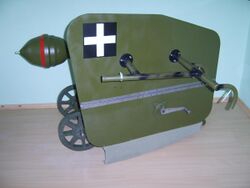Engineering:Hungarian 44M
| 44M Buzogányvető | |
|---|---|
 A replica 44M Buzogányvető on a wheeled mount | |
| Type | Anti-tank rocket |
| Place of origin | Hungary |
| Service history | |
| In service | 1944-1945 |
| Used by | Royal Hungarian Army |
| Wars | World War II |
| Production history | |
| Designer | Hungarian Institute of Military Science (HTI) |
| Designed | 1942 |
| Manufacturer | Weiss Manfréd |
| Produced | 1944 |
| No. built | 600-700 rocket systems |
| Variants | HEAT (high-explosive anti-tank) HE (high-explosive) |
| Specifications | |
| Diameter | 215 mm |
| Crew | 3 |
| Effective firing range | 500-1200 m |
| Maximum firing range | 2000 m |
| Warhead | 4.2 kg HEAT |
Detonation mechanism | contact |
| Engine | solid-fuel rocket |
| Speed | 56 m/s |
Launch platform | Tripod mount, wheeled machine gun mount, truck, tank |
The Hungarian 44M "Buzogányvető" (English: Macethrower) was an unguided anti-tank rocket designed in Hungary for use against Soviet armour and personnel in World War II. The rocket system consisted of a pair of solid fuel rockets with two types of warheads available. It was regarded as one of the most effective anti-tank weapons used in World War II. Production started in the spring of 1944 and ended on 20 December 1944 when Soviet troops captured the Weiss Manfréd Factory.[1]
Development and operation
In 1942, the Hungarian Institute of Military Science (HTI) began work to develop an easy to produce weapon capable of destroying heavily armoured Soviet tanks. Germany had started work on a wire-guided missile but was unwilling to share the technology with Hungary.[1]
The 44M Buzogányvető consisted of a launcher capable of holding two rockets with the gunner operating from the weapon's left side. A tripod was developed for use by the three man crew on the ground, but this mount was difficult to maneuver and rocket launcher crews often used captured Soviet wheel mounts from the PM M1910 or SG-43 Goryunov machine guns. The 44M Buzogányvető system was also mounted in the back of the 38M Botond all-terrain truck and on the rear of the Toldi II light tank.[1]
The first of two types of rockets produced was a high-explosive anti-tank warhead (HEAT) round known as ’Buzogány’ (mace). With 4.2 kg of explosives, this shaped charge was capable of penetrating 300 mm of armour or concrete and could destroy any tank of World War II, even the most armoured heavy tanks, from a maximum distance of 1200 m. A high explosive (HE) round, referred to as 'Zápor' (rainfall, shower), was also available for use in an anti-personnel role. Both types were spin-stabilized.[2]
Of the 600-700 twin rocket launchers produced, the majority were used for the defense of Budapest in the winter of 1944/1945, referred to as the Siege of Budapest.[2]
See also
- 44M Lidérc (WWII Hungarian acoustic proximity fused air-to-air rocket)
- Anti-tank warfare
- Anti-tank missile
- Anti-tank gun
- List of anti-tank missiles
- List of military rockets
- List of anti-tank guns
References
- ↑ 1.0 1.1 1.2 Károlyi “Karika” Németh (2 April 2014). "Hungarian Toldi II LT with 44M.". ftr.wot-news.com. http://ftr.wot-news.com/2014/04/02/hungarian-toldi-ii-lt-with-44m-buzoganyveto-anti-tank-rocket-launcher/. Retrieved 17 May 2015.
- ↑ 2.0 2.1 "Hungarian anti-tank rocket launcher, Mace". survincity.com. http://survincity.com/2010/05/hungarian-anti-tank-rocket-launcher-mace/. Retrieved 17 May 2015.
Template:Weapons of HungaryTemplate:Hungary-stub

